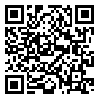Volume 13, Issue 52 (2020)
LCQ 2020, 13(52): 111-138 |
Back to browse issues page
Download citation:
BibTeX | RIS | EndNote | Medlars | ProCite | Reference Manager | RefWorks
Send citation to:



BibTeX | RIS | EndNote | Medlars | ProCite | Reference Manager | RefWorks
Send citation to:
Hesampoor S, heidary jamebozorgi F. Rostam in the Twenty Second Century:
Genre Analysis. LCQ 2020; 13 (52) :111-138
URL: http://lcq.modares.ac.ir/article-29-42181-en.html
URL: http://lcq.modares.ac.ir/article-29-42181-en.html
1- member of faculty shiraz university
2- Research Assistant, Shiraz University , fahimeheidary@yahoo.com
2- Research Assistant, Shiraz University , fahimeheidary@yahoo.com
Abstract: (1917 Views)
“Rostam in the Twenty-second Century”, written by Sanatizadeh Kermani, is the first science fiction novel in Iran. Noteworthy, science fiction is widely known as a genre in children's literature in Iran. The current paper attempted to examine various aspects of this novel, regarding its genre and also identify its readers. For this purpose, the main components of the genre, namely science, imagination, materialism, novum, prediction and nostalgia along with three components identified by the researchers, which are taboo-breaking, hopefulness and empowerment, were employed to analyze the novel. The results showed that the novel seeks to address issues such as the pursuit of happiness in modernity, the power of modern man, and even resurrection of the dead, with the aim of comparing tradition and modernity, and it generally targets adults as its readers. Therefore, it could be said that the novel was written for adults, but since the youngsters are very well acquainted with technology these days, it can also be suitable for adolescents as well. Moreover, by focusing on the scientific and imaginative aspect of the novel, it became apparent that although this novel does not employ a specific scientific justification for the probability of the events, it has applied imagination to an area which is beyond human power. In conclusion, the novel can be considered as a science fiction story as it creates a novum that led readers to alienation
Article Type: Qualitative Research |
Subject:
Child literature
Received: 2020/04/17 | Accepted: 2020/11/24 | Published: 2020/12/30
Received: 2020/04/17 | Accepted: 2020/11/24 | Published: 2020/12/30
Send email to the article author
| Rights and permissions | |
 |
This work is licensed under a Creative Commons Attribution-NonCommercial 4.0 International License. |








